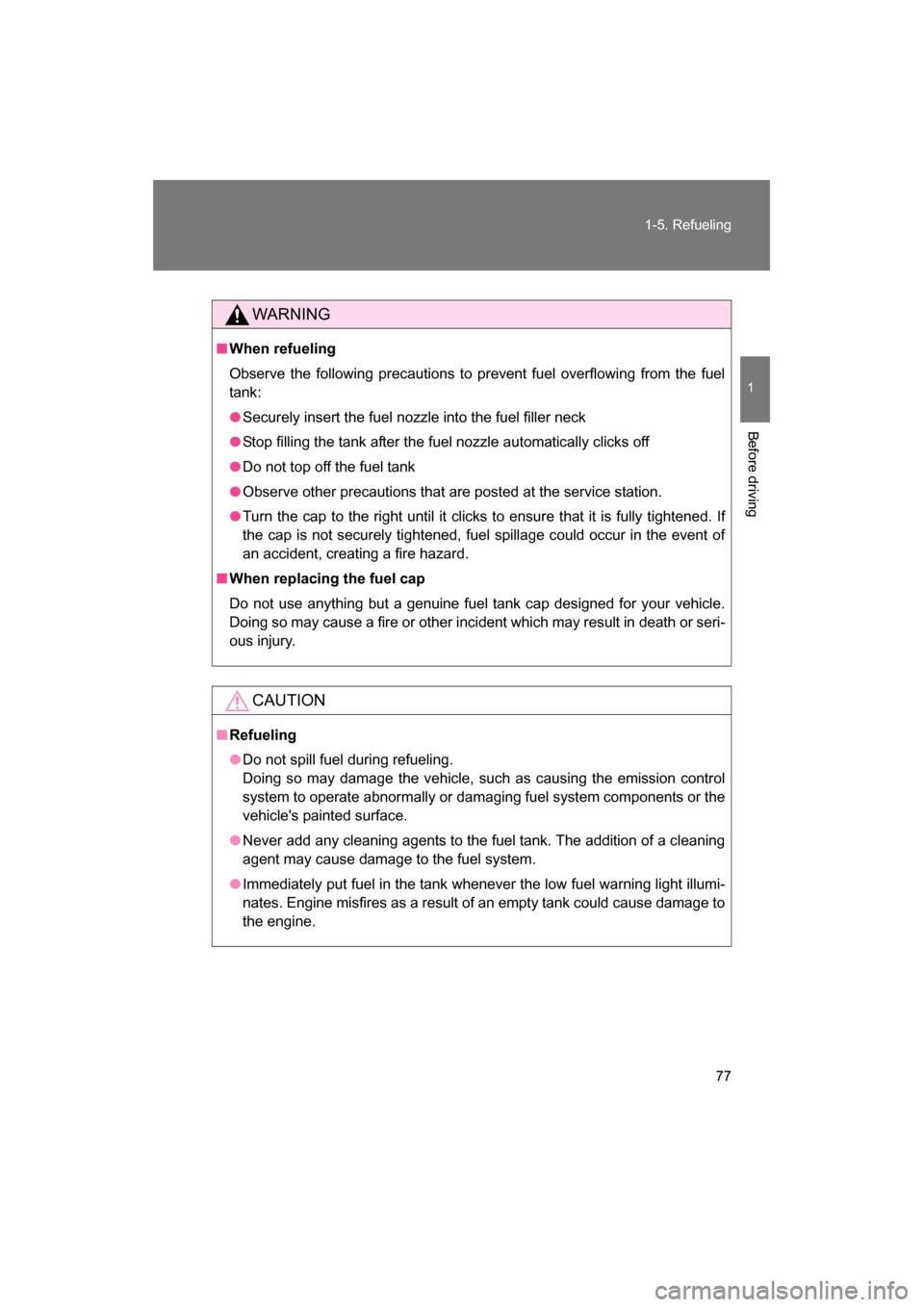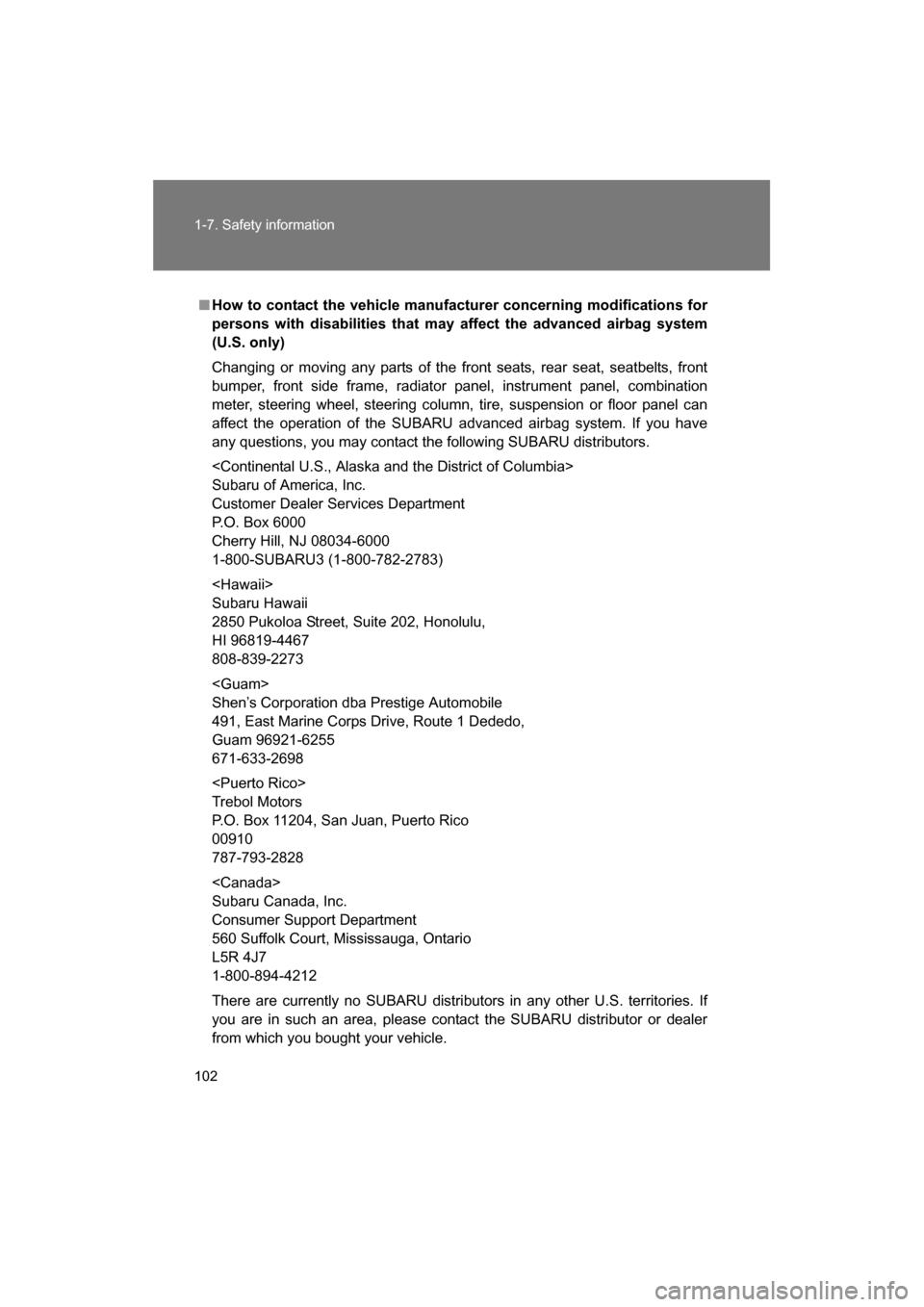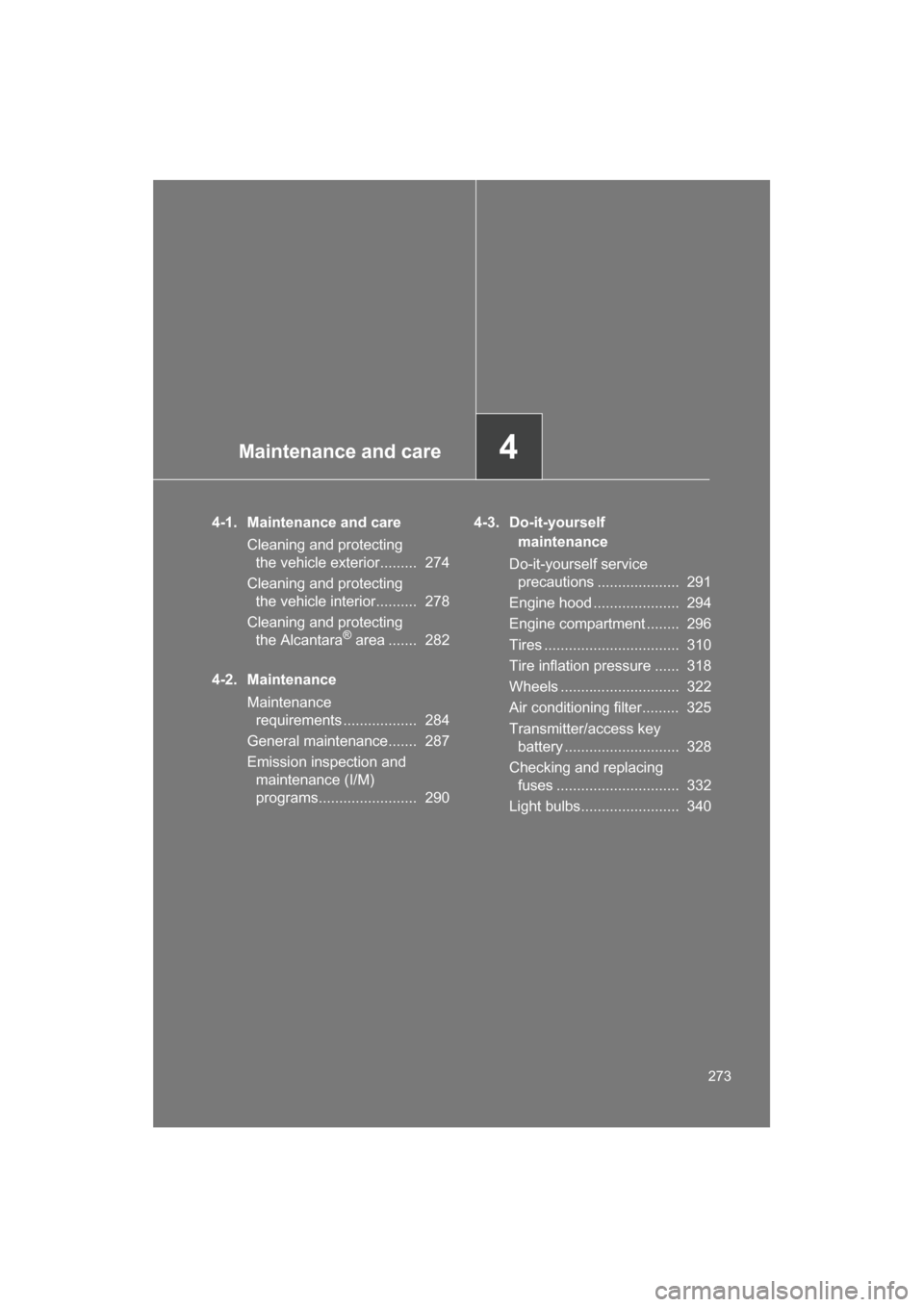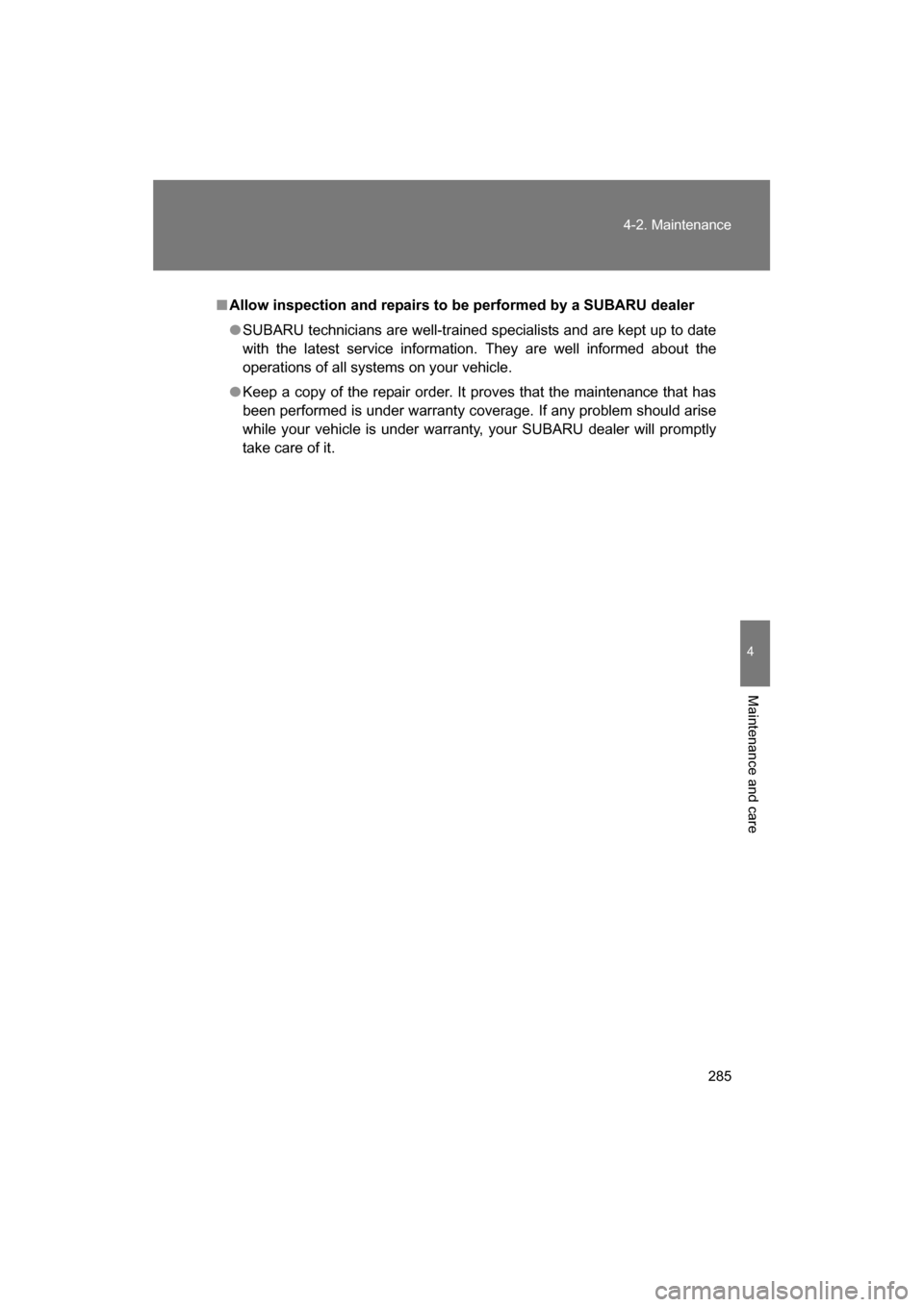2014 SUBARU BRZ service
[x] Cancel search: servicePage 4 of 488

TABLE OF CONTENTSIndex
4
4-1. Maintenance and care
Cleaning and protecting the vehicle exterior ........... 274
Cleaning and protecting the vehicle interior ............ 278
Cleaning and protecting the Alcantara ®
area.......... 282
4-2. Maintenance Maintenance requirements .................... 284
General maintenance ......... 287
Emission inspection and maintenance (I/M)
programs .......................... 290
4-3. Do-it-yourself maintenance
Do-it-yourself service precautions ...................... 291
Engine hood ....................... 294
Engine compartment .......... 296
Tires ................................... 310
Tire inflation pressure......... 318
Wheels ............................... 322
Air conditioning filter ........... 325
Transmitter/access key battery .............................. 328
Checking and replacing fuses ................................ 332
Light bulbs .......................... 340 5-1. Essential information
Hazard warning flashers ..... 356
If your vehicle needs to be towed ................................ 357
If you think something is wrong ................................ 364
Fuel pump shut off system .............................. 365
5-2. Steps to take in an emergency
If a warning light turns on or a warning buzzer
sounds... .......................... 366
If you have a flat tire ........... 380
If the engine will not start .... 391
If the select lever cannot be shifted from P ................... 394
If you lose your keys ........... 395
If the access key does not operate properly ............... 396
If the battery is discharged ........................ 400
If your vehicle overheats..... 405
If the vehicle becomes stuck ................................. 408
4Maintenance and care5When trouble arises
Page 17 of 488

17
Scrapping of your SUBARUThe SRS airbag and seatbelt pretensioner devices in your SUBARU contain
explosive chemicals. If the vehicle is scrapped with the airbags and seatbelt
pretensioners left as they are, this may cause an accident such as fire. Be
sure to have the systems of the SRS airbag and seatbelt pretensioner
removed and disposed of by a qualified service shop or by your SUBARU
dealer before you scrap your vehicle.
Perchlorate Material
Special handling may apply, See www.dtsc.ca.gov/hazardouswaste/perchlorate.
Your vehicle has components that may contain perchlorate. These
components may include airbag, seatbelt pretensioners, and transmitter
batteries.
WARNING
■General precautions while driving
Driving under the influence: Never drive your vehicle when under the influ-
ence of alcohol or drugs that have impaired your ability to operate your vehi-
cle. Alcohol and certain drugs delay reaction time, impair judgment and
reduce coordination, which could lead to an accident that could result in
death or serious injury.
Defensive driving: Always drive defensively. Anticipate mistakes that other
drivers or pedestrians might make and be ready to avoid accidents.
Driver distraction: Always give your full attention to driving. Anything that dis-
tracts the driver, such as adjusting controls, talking on a cellular phone or
reading can result in a collision with resulting death or serious injury to you,
your occupants or others.
■General precaution regarding children’s safety
Never leave children unattended in the vehicle, and never allow children to
have or use the key.
Children may be able to start the vehicle or shift the vehicle into neutral.
There is also a danger that children may injure themselves by playing with
the windows or other features of the vehicle. In addition, heat build-up or
extremely cold temperatures inside the vehicle can be fatal to children.
Page 77 of 488

77
1-5. Refueling
1
Before driving
WARNING
■When refueling
Observe the following precautions to prevent fuel overflowing from the fuel
tank:
●Securely insert the fuel nozzle into the fuel filler neck
●Stop filling the tank after the fuel nozzle automatically clicks off
●Do not top off the fuel tank
●Observe other precautions that are posted at the service station.
●Turn the cap to the right until it clicks to ensure that it is fully tightened. If
the cap is not securely tightened, fuel spillage could occur in the event of
an accident, creating a fire hazard.
■When replacing the fuel cap
Do not use anything but a genuine fuel tank cap designed for your vehicle.
Doing so may cause a fire or other incident which may result in death or seri-
ous injury.
CAUTION
■Refueling
●Do not spill fuel during refueling.
Doing so may damage the vehicle, such as causing the emission control
system to operate abnormally or damaging fuel system components or the
vehicle's painted surface.
●Never add any cleaning agents to the fuel tank. The addition of a cleaning
agent may cause damage to the fuel system.
●Immediately put fuel in the tank whenever the low fuel warning light illumi-
nates. Engine misfires as a result of an empty tank could cause damage tothe engine.
Page 102 of 488

102
1-7. Safety information
■How to contact the vehicle manufacturer concerning modifications for
persons with disabilities that may affect the advanced airbag system
(U.S. only)
Changing or moving any parts of the front seats, rear seat, seatbelts, front
bumper, front side frame, radiator p anel, instrument panel, combination
meter, steering wheel, steering column, tire, suspension or floor panel can
affect the operation of the SUBARU advanced airbag system. If you have
any questions, you may contact the following SUBARU distributors.
Subaru of America, Inc.
Customer Dealer Services Department
P.O. Box 6000
Cherry Hill, NJ 08034-6000
1-800-SUBARU3 (1-800-782-2783)
Subaru Hawaii
2850 Pukoloa Street, Suite 202, Honolulu, HI 96819-4467 808-839-2273
Shen’s Corporation dba Prestige Automobile
491, East Marine Corps Drive, Route 1 Dededo,
Guam 96921-6255 671-633-2698
Trebol Motors
P.O. Box 11204, San Juan, Puerto Rico 00910 787-793-2828
Subaru Canada, Inc.
Consumer Support Department
560 Suffolk Court, Mississauga, Ontario
L5R 4J7
1-800-894-4212
There are currently no SUBARU distributors in any other U.S. territories. If
you are in such an area, please contact the SUBARU distributor or dealer
from which you bought your vehicle.
Page 151 of 488
![SUBARU BRZ 2014 1.G Owners Manual 151
2-1. Driving procedures
2
When driving
■New vehicle break-in driving (the first 1000 miles [1600 km])
The performance and long life of your vehicle are dependent on how you
handle and care for SUBARU BRZ 2014 1.G Owners Manual 151
2-1. Driving procedures
2
When driving
■New vehicle break-in driving (the first 1000 miles [1600 km])
The performance and long life of your vehicle are dependent on how you
handle and care for](/manual-img/17/7179/w960_7179-150.png)
151
2-1. Driving procedures
2
When driving
■New vehicle break-in driving (the first 1000 miles [1600 km])
The performance and long life of your vehicle are dependent on how you
handle and care for your vehicle while it is new. Follow these instructions
during the first 1000 miles (1600 km):
●Do not allow the engine speed to exceed 4000 rpm except in an emer-
gency.
●Do not drive at one constant engine or vehicle speed for a long time,
either fast or slow.
●Avoid starting suddenly and rapid acceleration, except in an emergency.
●Avoid hard braking, except in an emergency.
The same break-in procedures should be applied to an overhauled engine,
newly mounted engine or when brake pads or brake linings are replaced
with new ones.
■Replacement of brake pad and lining
The front disc brake and the rear disc brake have audible wear indicators on
the brake pads. If the brake pads wear close to their service limit, the wear
indicator makes a very audible scraping noise when the brake pedal is
applied.
■Breaking-in of new brake pads and linings
When replacing the brake pad or li ning, use only genuine SUBARU parts.
After replacement, the new parts must be broken in as follows.
Brake pad and lining
While maintaining a speed of 30 to 40 mph (50 to 65 km/h), step on the
brake pedal lightly. Repeat this five or more times. If you hear this scraping noise each time
you apply the brake pedal, have the
brake pads serviced by your SUBARU
dealer as soon as possible.
Page 273 of 488

Maintenance and care4
273
4-1. Maintenance and careCleaning and protecting the vehicle exterior......... 274
Cleaning and protecting the vehicle interior.......... 278
Cleaning and protecting the Alcantara ®
area ....... 282
4-2. Maintenance Maintenance requirements .................. 284
General maintenance....... 287
Emission inspection and maintenance (I/M)
programs........................ 290 4-3. Do-it-yourself
maintenance
Do-it-yourself service precautions .................... 291
Engine hood ..................... 294
Engine compartment ........ 296
Tires ................................. 310
Tire inflation pressure ...... 318
Wheels ............................. 322
Air conditioning filter......... 325
Transmitter/access key battery ............................ 328
Checking and replacing fuses .............................. 332
Light bulbs........................ 340
Page 284 of 488

284
4-2. Maintenance
Maintenance requirements
■Repair and replacement
It is recommended that genuine SUBARU parts be used for repair to ensure
performance of each system. If non-SUBARU parts are used in replacement
or if a repair shop other than a SUBARU dealer performs repairs, warranty
coverage may be affected.
To ensure safe and economical driving, day-to-day care and regular
maintenance is essential. It is the
owner’s responsibility to perform
regular checks. SUBARU recommends the following maintenance.
■General maintenance
Should be performed on a daily basis. This can be done by your-
self or by a SUBARU dealer.
■Scheduled maintenance
Should be performed at specified intervals according to the
maintenance schedule.
For details about maintenance items and schedules, refer to the “War-
ranty and Maintenance Booklet”.
■Do-it-yourself maintenance
You can perform some maintenance procedures yourself.
Please be aware that do-it-yourself maintenance may affect war-
ranty coverage.The use of SUBARU Service Manuals is recommended.
For details about warranty coverage, see the separate “Warranty and
Maintenance Booklet”.
Page 285 of 488

285
4-2. Maintenance
4
Maintenance and care
■Allow inspection and repairs to be performed by a SUBARU dealer
●SUBARU technicians are well-trained specialists and are kept up to date
with the latest service information. They are well informed about the
operations of all systems on your vehicle.
●Keep a copy of the repair order. It proves that the maintenance that has
been performed is under warranty coverage. If any problem should arise
while your vehicle is under warranty, your SUBARU dealer will promptly
take care of it.